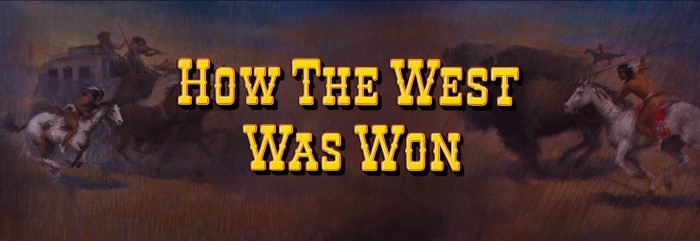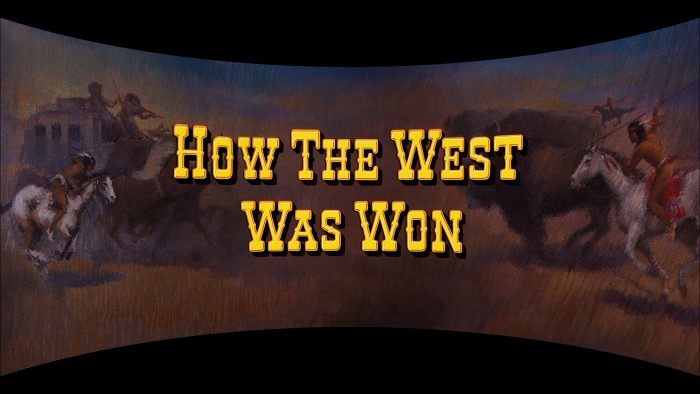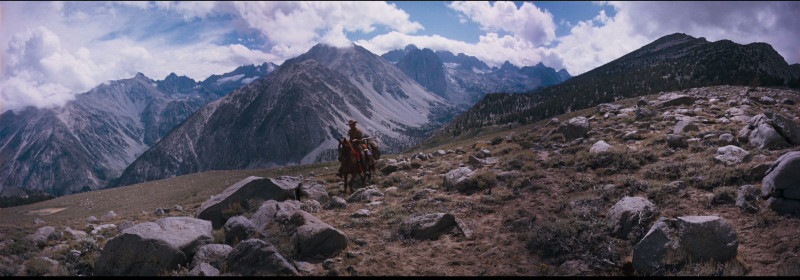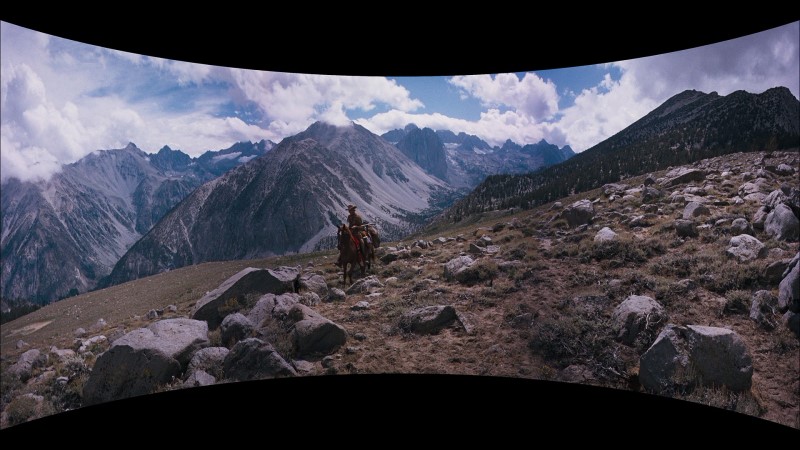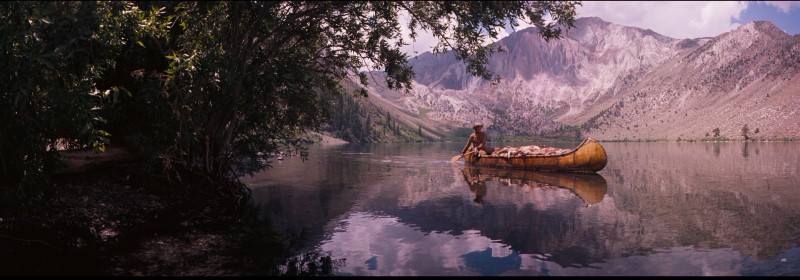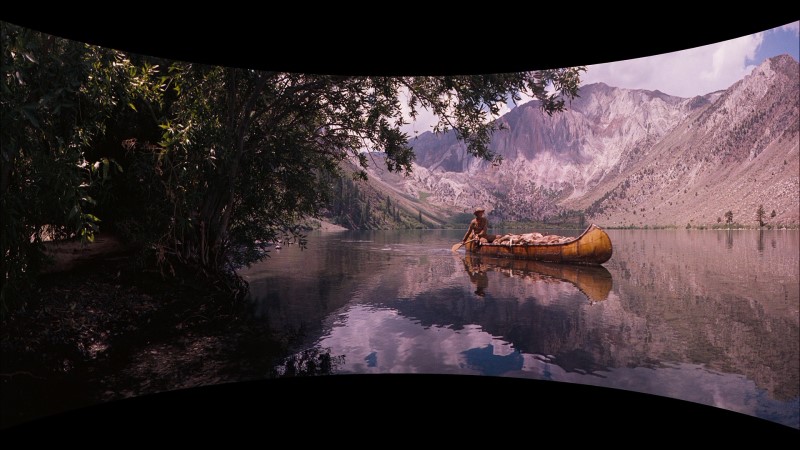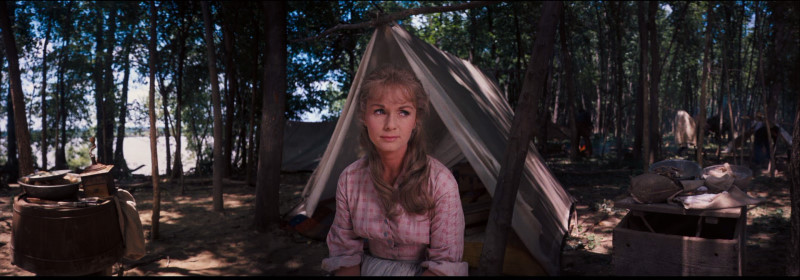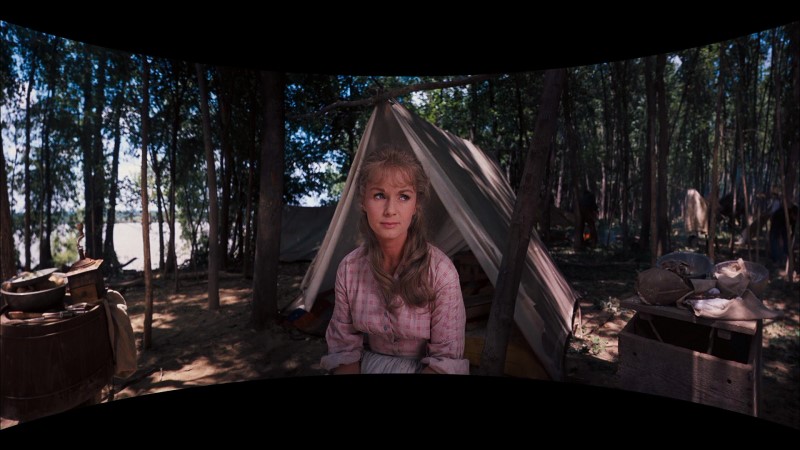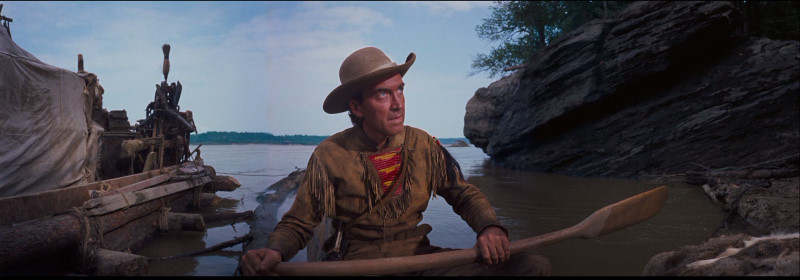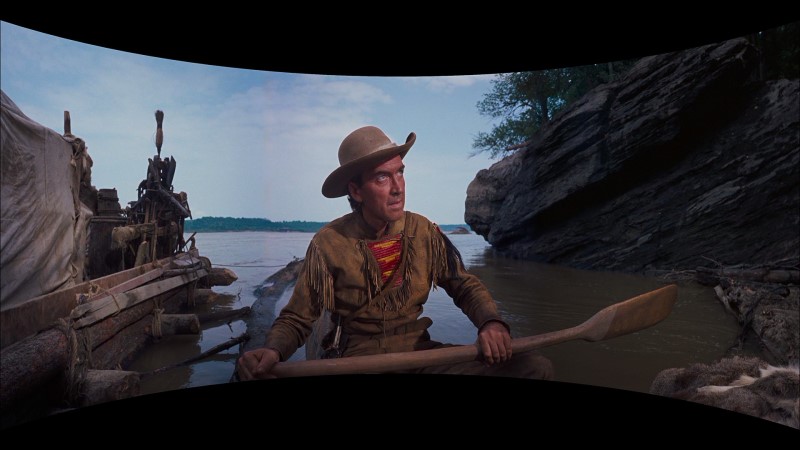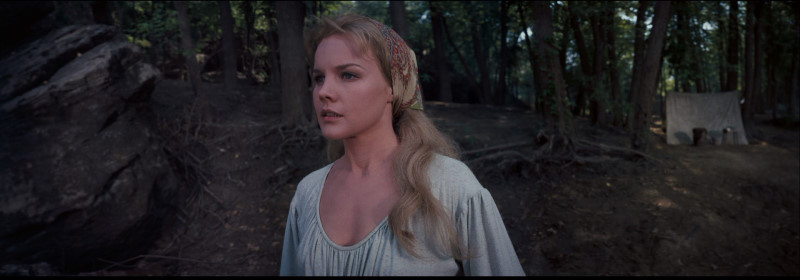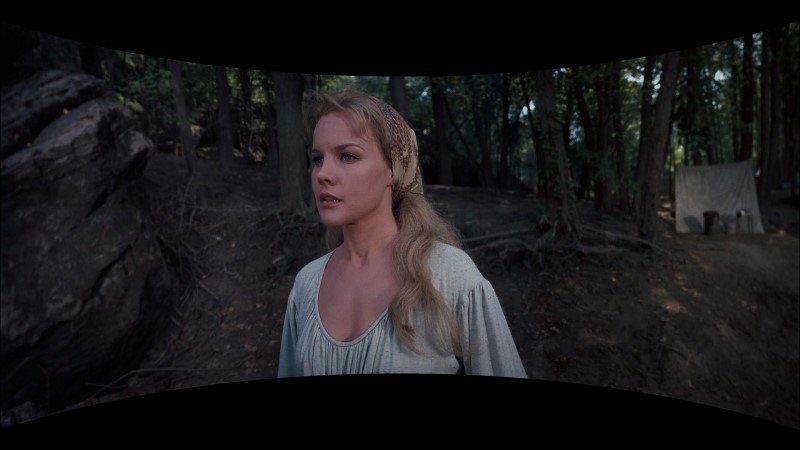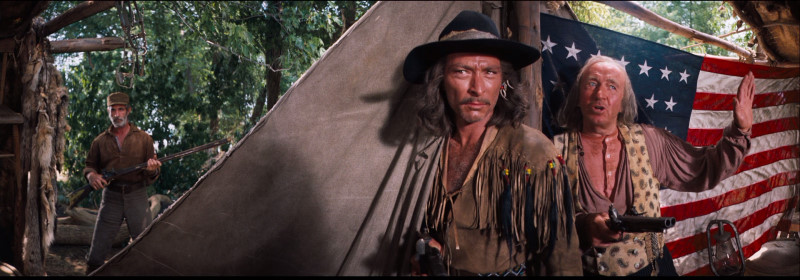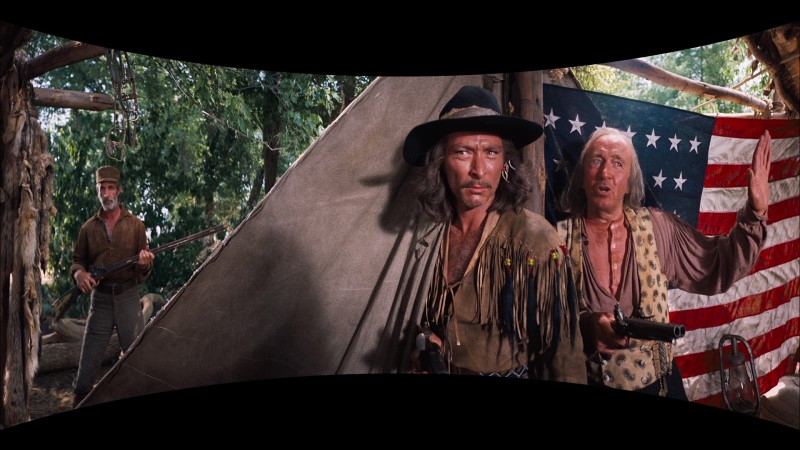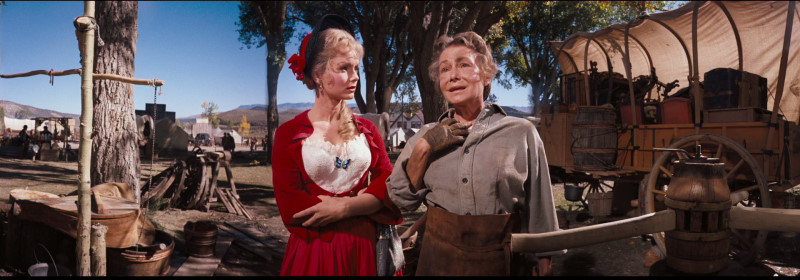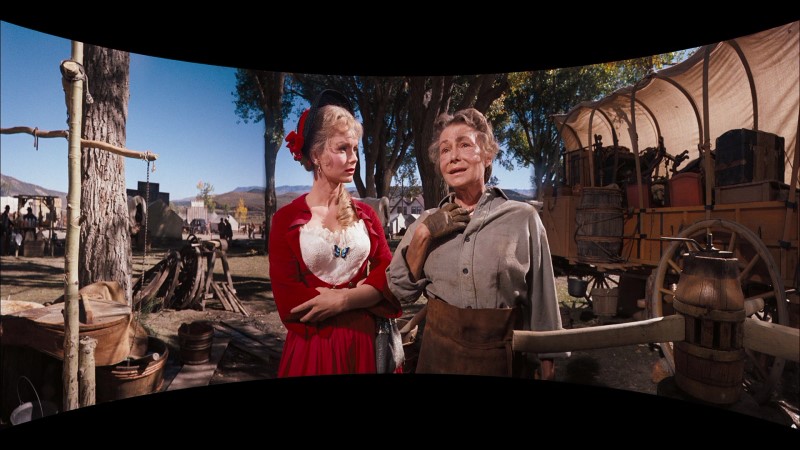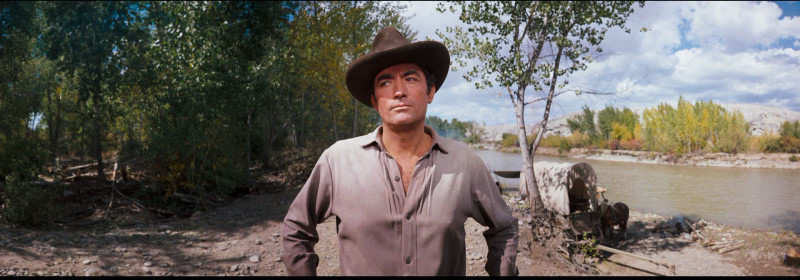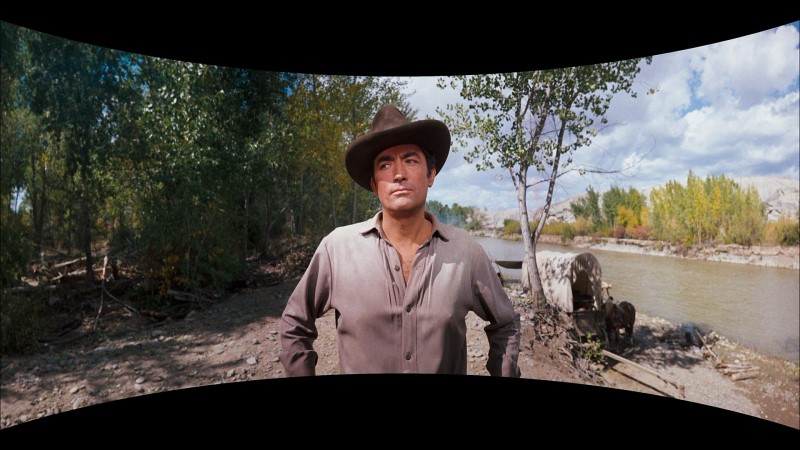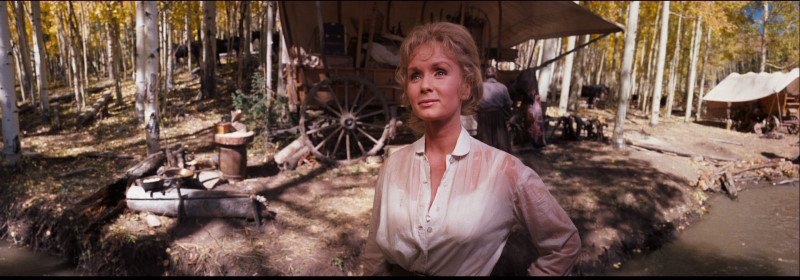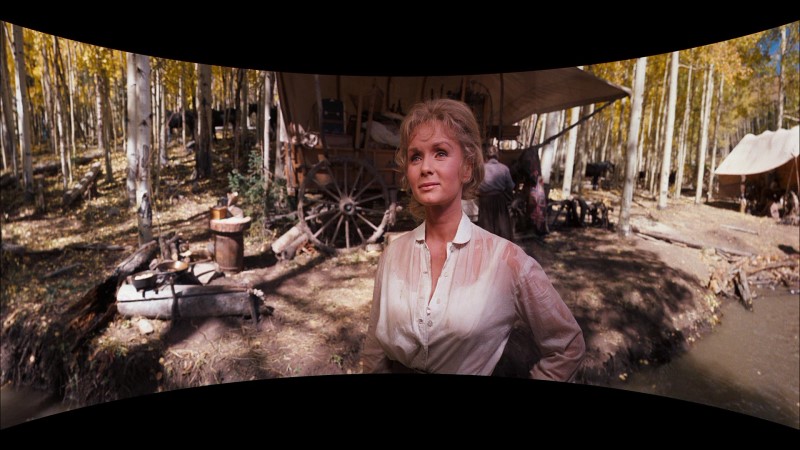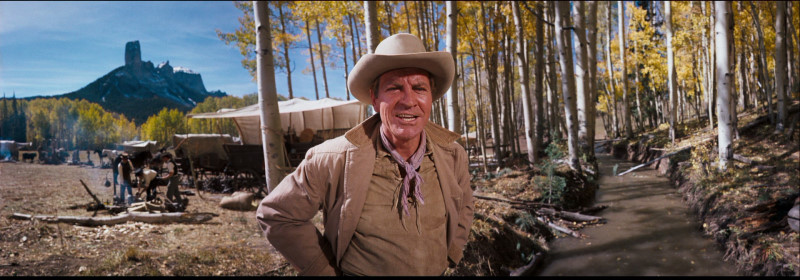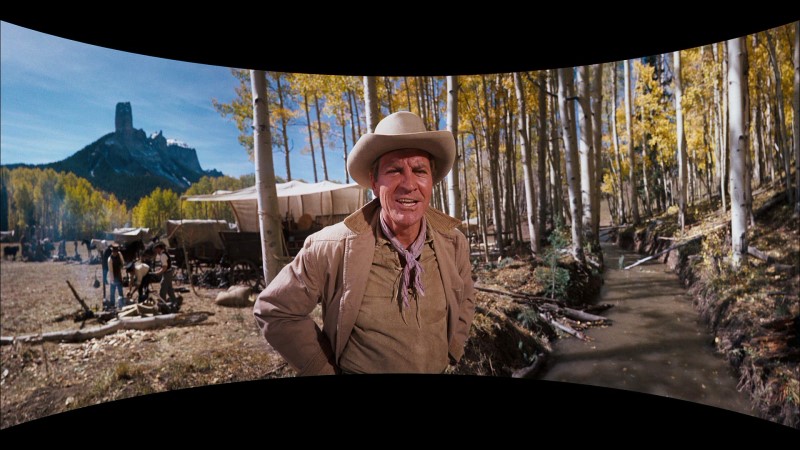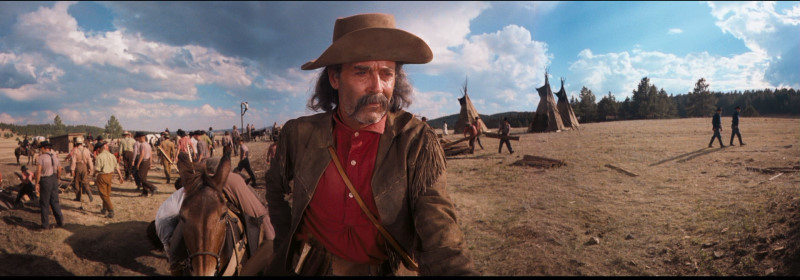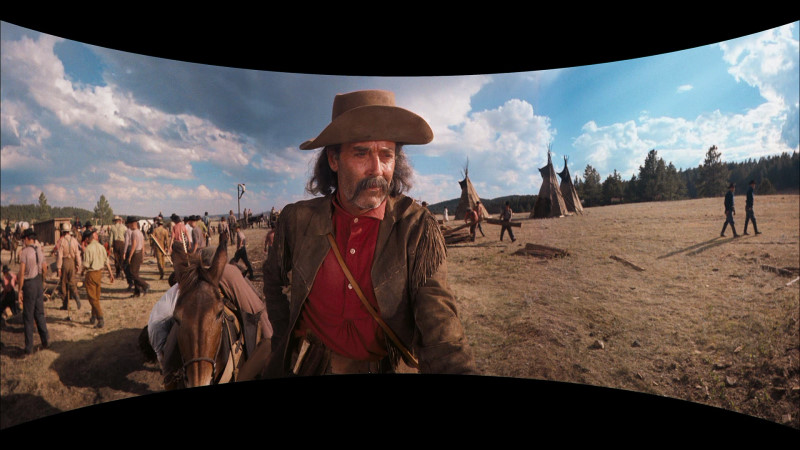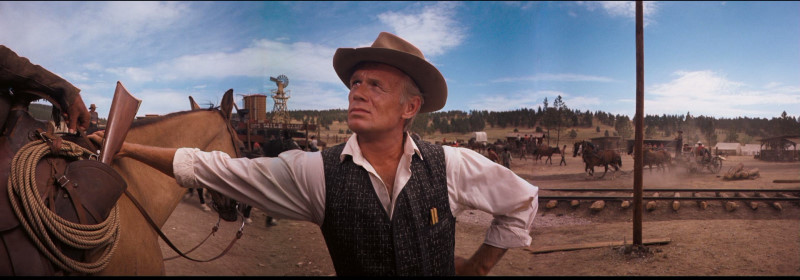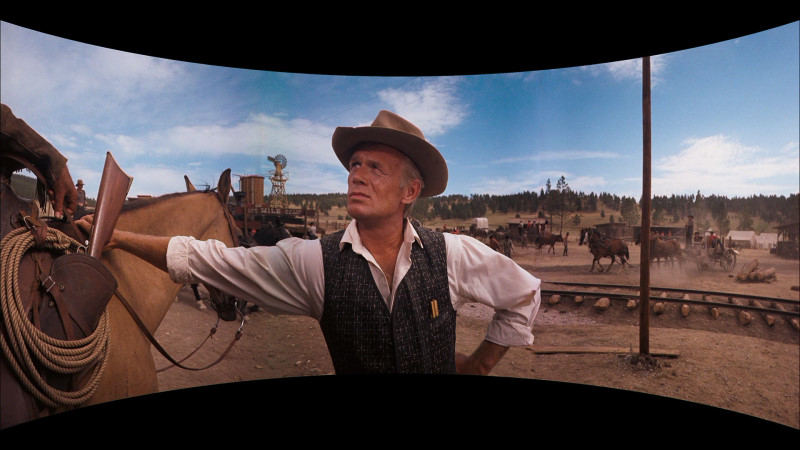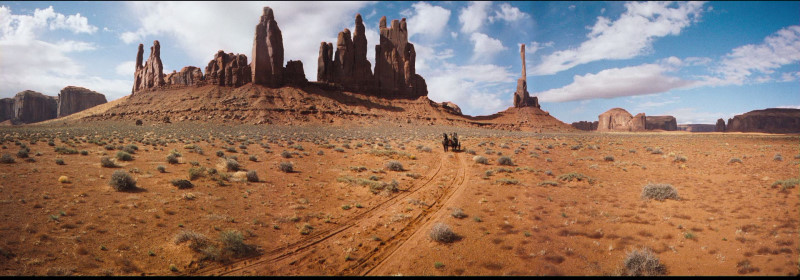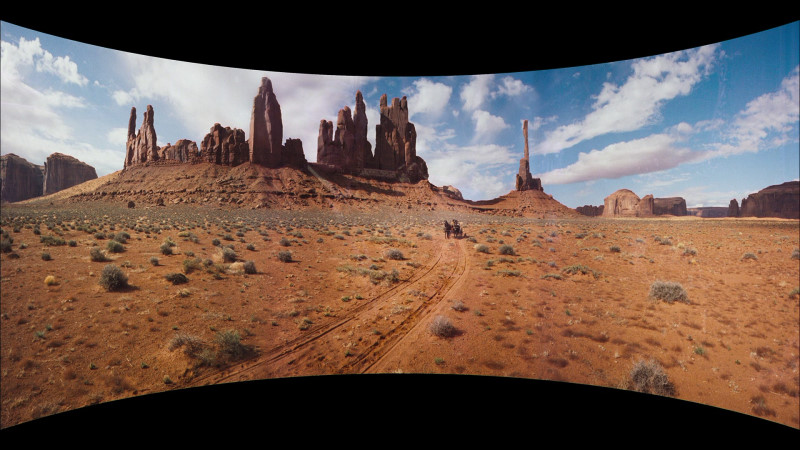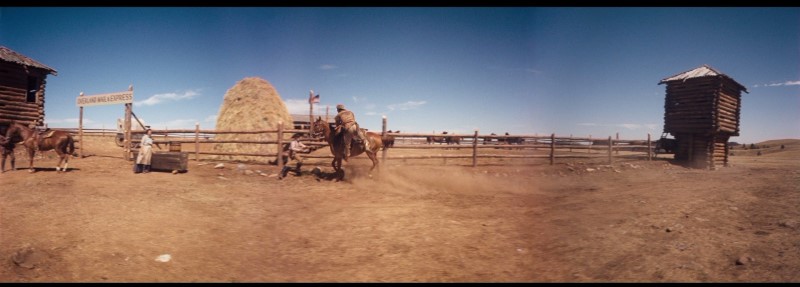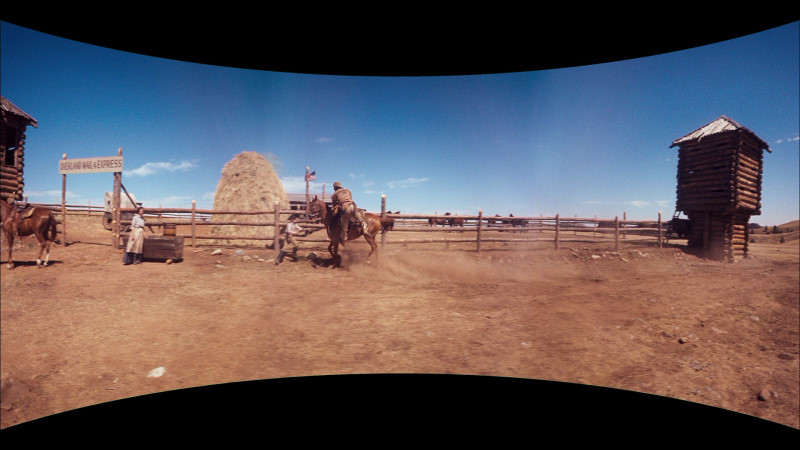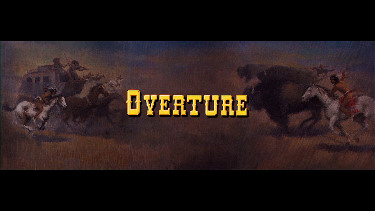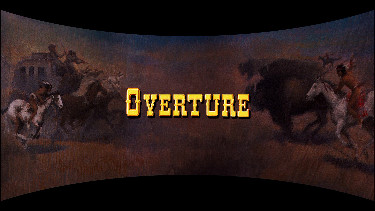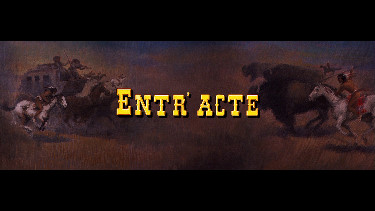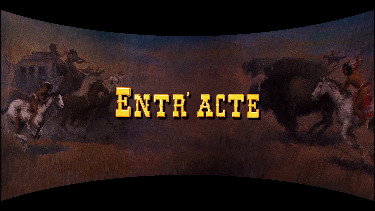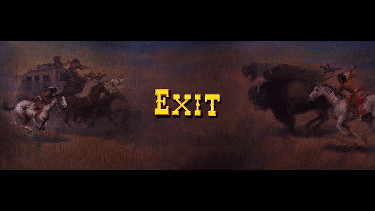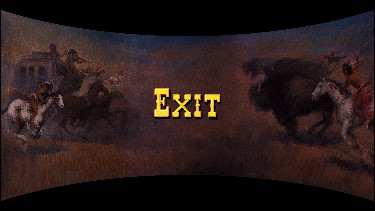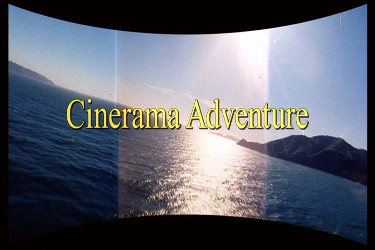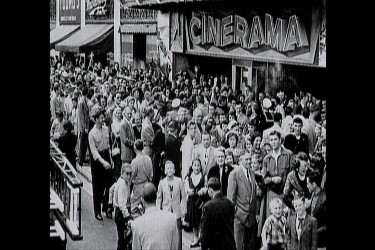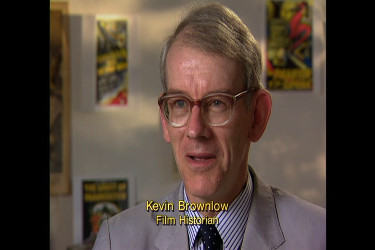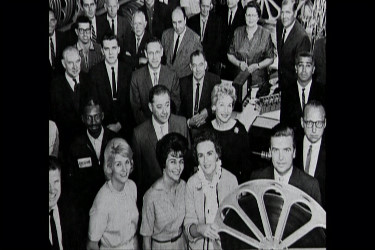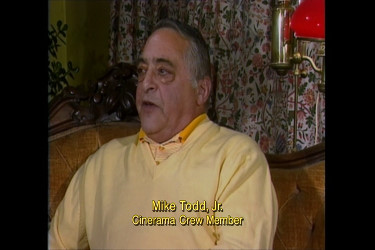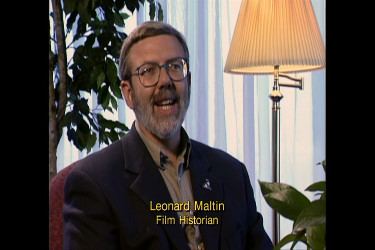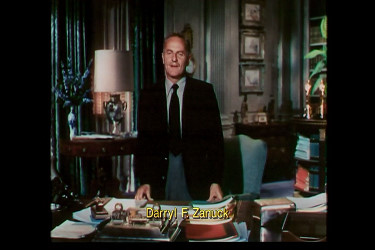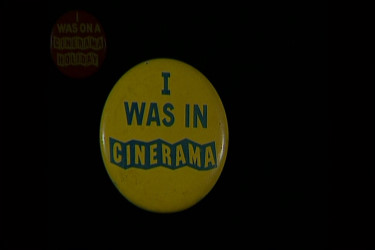|
How the West Was Won (2-disc) [Blu-ray]
(John Ford, Henry Hathaway,
George Marshall and Richard Thorpe, 1962)
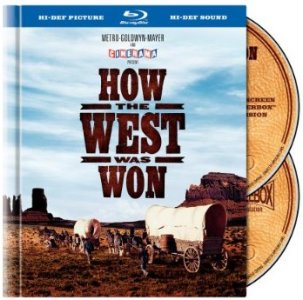
|
|



 |
|
Reissued January 4th, 2011:


|
Review by Leonard Norwitz
Captures by Gary Tooze
Studio:
Theatrical: Warner Brothers
Blu-ray: Warner Home Video
Disc:
Region: Free
Runtime: 2:44:40
Chapters: 41
Disc 1 - Feature
Size: 37.3 GB
Disc 2 (SmileBoxed) - Feature
Size: 36.4 GB
Case: Custom book-style Blu-ray case
Release date: September 9th, 2008
Video:
Aspect ratio: 2.90:1 / 1.78
Resolution: 1080p
Video codec: VC-1
Audio:
English TrueHD 5.1, English Dolby Digital 5.1, DUBs:
French, Spanish, German and Italian (5.1)
Subtitles:
English, French, Spanish, Chinese (Simplified and
traditional), Danish, Dutch, Finnish, German Italian,
Japanese, Norwegian, Portuguese and Swedish,
Extras:
• Audio Commentary by filmmaker David Strohmaier,
Cinerama, Inc. Director John Sittig, Film Historian Rudy
Behlmer, Music Historian Jon Burlingame, and Stuntman
Loren James
• 44-page full color book
• David Strohmaier's 2002 Documentary: Cinerama
Adventure (93.00)
•
Disc 2: 1080p Smilebox Curved Screen Simulation
The Film:
The history of the extraordinary and short-lived (10
years) innovation known as Cinerama is a fascinating
chapter in motion pictures. It is laid out lovingly and
critically in David Strohmaier's 2002 Documentary:
Cinerama Adventure, included as a bonus feature on
disc one of this equally extraordinary 2-disc set from
Warner. In my opinion, the set in worth the price for
the documentary alone, but Warner is offering both this
and the feature film in two complete visual
presentations for less than many other current Blu-ray
titles. For all its flaws – narrative and technical –
this new set is highly recommended.

For those unfamiliar with Cinerama, you should know that
it was the brainchild of Fred Waller, known for his
innovations since the silent film days, and commercially
developed by producer Merian C. Cooper (yes, that Merian
C. Cooper of King Kong) and explorer and
journalist, Lowell Thomas. The idea was to offer the
audience an immersive visual and aural experience,
emotionally and neurologically involving such as they
had never had before – or, as many still assert, since,
including IMAX.
The technology involved the use of three cameras mounted
on a single chassis, each with a fixed focal length lens
of 28 mm on a horizontal axis with the outer cameras
shooting across each other's field of view. The
resulting angle of view was enormous, about 147 degrees.
In turn, the three reels of film would be shown in
specially constructed theatres by three projectors
spread across the rear wall, again with the outer
projectors crossing their images onto a radically curved
screen. – From the point of view of most people in the
audience the resulting image would completely account
for one's peripheral vision. The aspect ratio was over
2.5:1. though the curved screen made the outer panels
appear to be less wide than the center.
The audio track was run on a separate tape altogether,
and adjusted on the spot by a technician for the effects
of that day's audience, humidity, and theatre acoustics.
It was fed into seven discrete channels: 5 behind the
louvered and perforated screen, and 2 rears. The dynamic
range and fidelity of this system would dwarf anything
we hear in theatres today - DTS notwithstanding.
At first, there was only one theatre – the Broadway
Theatre in New York City (where I saw This is Cinerama
in 1954) – but that year, 1952, the year that brought us
Singin' in the Rain, this lone movie house was
responsible for the highest grossing film of the year!
We're talking going to the movies like going to an opera
matinee, only with several shows a day. Big ticket,
reserved seats, no popcorn - the whole shebang. The
first features were travelogues, but after a few years,
the powers that were thought the time had come to try
their hand at a real feature with real actors. This was
a risky proposition because there still remained serious
technical problems with the process - and, perhaps, more
important, Cinerama presented logistic and dramatic
challenges for the actors not seen before, nor since –
even with blue screen.
The Movie : 6
It would be nice if we could say that the movie lives up
to the technology. And, I do so say. The screenplay is
decent – it even won an Oscar for Best Writing. But to
be honest, I thought the 1978 TV miniseries
Centennial to be more satisfying. It was certainly
more faithful to the adventure that is America. On the
other hand, How The West Was Won is great family
entertainment. It is a musical, an adventure, a love
story – several in fact. It's got a non-stop cast and
visuals that can't be beat with a stick.
The difficulty really lies elsewhere: within the limits
of the medium. The director and photographer must take
great pains to place their actors so that they cross
from one panel to another, or look across to another
actor in a different panel, in ways that don't bring
attention to the technical limitations. You will see
actors in the foreground who ought to be looking here,
but are looking there. Another huge problem is its fixed
focal length. It wouldn't be so bad if it were say about
50 mm. But wide angle lenses do real perspective damage
in close up (just look at what Kubrick does with them
intentionally). We can't help notice that the movement
of just a few inches closer from ideal makes a person,
or some part of a person, seem momentarily gargantuan.
Image:
NOTE:
The below
Blu-ray
captures were ripped directly from the
Blu-ray
disc.
Cinerama's various technical and dramatic difficulties
are addressed by the commentators in the full length
commentary and in the documentary. But suffice to say
that the audience by and large was aware of only one of
them – and it was a doozy: The vertical moment where the
left and right panels met the center panel never quite
lined up. The audience was always aware of a visual
disconnect – a distressing violation of picture
integrity. Adding insult to injury, the three panels
would wiggle, slightly but noticeably, in relation to
each other.
In previous video presentations, the image was displayed
- warts and all - making the picture less than
satisfying. For this new
Blu-ray,
Warners developed software to align and blend the moment
of congruence – or lack thereof - to eliminate the
alignment problems that have nagged Cinerama from the
outset. The image is now stabilized and continuity
across the horizontal is superb – not perfect, but far
better than anyone ever saw it fifty years ago. Flaws
remain, and we see them plainly in the screen captures,
especially in scenes with large patches of sky or other
light areas: There is an occasional rippling of color –
a kind of vertical banding that belies an otherwise
awesome and invisible fix. Much of this could have been
addressed with more money, time and care – but make no
mistake, what we do see on this
Blu-ray,
for over 95% of the movie, is stunning: clear, with
excellent color, contrast, sharpness and dimensionality
- and – in respect to the vertical banding – not a real
issue.

The alignment problem, however, was not the only
challenge facing Warner engineers. The other difficulty
was what to do about the absence of a curved screen.
Most importantly, what do we do about the effect a
curved screen has on objects moving toward and past the
camera. On a curved screen, they appear to be moving in
a straight line, as they should. On a flat screen, they
appear to turn away from the camera as they get closer
to it.
Note the first scene in town where the wagons and horses
that pass to the camera's left and right appear to turn
sharply away from the camera at the last moment. We see
this problem on the video over and over, but most of the
time, it is too subtle to notice if you're not looking
for it. The worst case example is during the
Indian/wagon train chase. There's one brief shot (which
repeats itself after about a half minute) where the
horses should be traveling from right to left across the
screen, but instead appear to be going in circles. It's
quite amusing, actually. Warner's Smilebox curved screen
processing does not really cure the
problem, though it appears to be less pronounced simply
because the extreme left and right is cropped enough to
notice. I found Smilebox neurologically distressing to
watch because of motion problems in the outer panels –
so much so I couldn't endure it long enough to know what
was causing them.
In any case, if you want a clue of what Cinerama is
supposed to look like, given your flat screen display,
simply turn to the final couple of minutes in the
documentary. While we can see the disastrous effects of
the vignetting, directionality is correct. Resolution
sucks, but the results are plain enough.
Otherwise, and better still, check the newspapers for
Hollywood's Cinerama Dome, the New Neon Cinema in
Dayton, Ohio, the Seattle Cinerama, or the Pictureville
Cinema at the National Media Museum in Bradford,
England. They play the occasional reprise of one or
another of surviving and new Cinerama prints from time
to time.
NOTE - additional: A second try on another day and no
dizzyness with Smilbox. As I said, it may have been
something I ate. Taking the advice of David Strohmaeir,
I moved my sitting position closer to the screen so that
the image covered all of my vision. This was a serious
improvement in respect to involvement, and at no
apparent concern about pixels. On the other hand, I
found the disproportionate size of people at the outer
panels to exacerbate the perspective problems inherent
in the medium. These result largely from reliance solely
on a wide angle lenses creating a unnatural sense of
movement by actors coming toward and walking away from
the camera. It's as if they are walking on one of those
airport pedestrian movers. Very disconcerting.
CLICK EACH
BLU-RAY
CAPTURE TO SEE ALL IMAGES IN FULL 1920X1080 RESOLUTION
Vertical Disconnect visible
Audio
& Music:
7/7
While nothing compares to the original theatrical
soundtrack, the new uncompressed Dolby True HD 5.1 is a
knockout. The choruses – and there are many – have a
breadth that feels as palpable as anything on video.
Dialog is crisp and never buried so deep we need
subtitles to clarify. Powerful surrounds come in just
when we need them. Check the rapids scene, or the Indian
attack on the wagon train or the disastrous logjam on
the train. Hold on to those seats.
While the big choral and orchestral passages are
executed in the Dolby True mix with a grandeur
appropriate to the material, dialog is disproportionally
subdued. To hear the latter clear enough would result in
being blasted out of one's seat by the big moments.
Spencer Tracy's voiceover narration is oddly much too
loud in comparison to the dialog, but not to the music .
Operations:
7
Nothing complicated or remarkable here. The Smilebox
(this is a logo, I ask you!) disc is minus the
commentary.
Extras:
8
As noted earlier, the documentary, Cinerama Adventure,
is a must see. It is a personal journey for so many
involved – and their drama will become your drama. The
footage is from mixed sources, but given that, the video
quality, even in 480i is very good. As for the
commentary, I wish it could have addressed the technical
issues more precisely instead of merely referring to
them. It was not clear to me that anyone not already
familiar with the limitations of Cinerama would be able
to extrapolate from their description. That said, except
for Rudy Behlmer's tendency to add the phrase, and so on
and so forth, about every other sentence, the commentary
is worthwhile. Mr. Behlmer is a man whom I am sure has
forgotten more than I know about cinema, and I would
have liked to have heard about some of it instead of his
well-meaning, but rather sweeping generalizations.
Sent to us in email from Dave Strohmaier, who made the
Cinerama Adventure documentary, and was the
Cinerama consultant for WBHV on "West" and on the
Smilebox process, that was developed for that
documentary (Thanks Dave!):
HOW SMILEBOX CURVED SCREEN CAME ABOUT
By Dave Strohmaier, director of Cinerama Adventure
"Cinerama was not the gimmick many people think it
was, gimmick or fads don't last 20 years and also have
several titles in the number on box office category. The
whole town of Hollywood helped me to make this historic
documentary from major studios to the smallest of film
libraries as well as several high end LA post production
and effects houses. They all did this for free, imagine
in Hollywood, free!
One of the results of doing this project was that the
original Cinerama 3 panel process was installed in two
American cities, Seattle and in Hollywood. Oh and yes
when it is shown on occasion at either of these two
cities. I and 3 other historian projection volunteers
are in the booth running it. People often have tears in
their eyes afterwards when they come to the projection
booth to visit us after the show to shake our hands. I
guess you could say that I and my projectionist pals
have seen 3 panel and 70mm Cinerama more often and
anyone other than perhaps the few remaining retired
Cinerama projectionist who ran it everyday in the old
days.
One of the things we wanted to do in the documentary was
to show people how different/special the Cinerama
experience was, as one would have to be about 50+ years
old to have seen it. Many young people would simply
laugh at a letterboxed image of the three panels on the
screen saying "what's so special about this, where is
this curve you keep talking about" and I would not blame
them. So we had award winning 3D graphics experts,
digital engineers, Oscar winning cinematographers, film
historians you name it get involve with creating a
"look" that we could use for the Cinerama shots in our
16 x 9 HD documentary. We wanted this effect/treatment
to be what people saw back then, although admittedly not
from the first 10 rows, as most people didn't see it
from those rows anyway, those were the 3.00+ seats.
After about two months of testing, and trying several
things, including projecting the original 3 panel
Cinerama focus charts on the Seattle Cinerama 146 degree
screen checking for horizontal and vertical distortions,
we came up with the SmileBox process for the
documentary. We needed to take full advantage of the
standard HD 16 x 9 frame and fill it edge to edge and
yet have a 146 degree effect that would approximate what
people saw in Cinerama theaters. Yes it has its
limitations to be sure, but within these limitations we
do feel we have succeeded. Next we showed it to several
film historians and to the Cinerama Corporation itself.
Cinerama still exists as a relatively inactive division
of Pacific Theaters here in California. When we showed
the first test on the "flat" screen at Arclight Cinemas
in Hollywood everyone was amazed at how effective the
SmileBox process was in recreating a Cinerama like
effect on a flat screen. Most of our documentary is
archival footage, old newsreels, interviews etc and they
are all in 4x3 inside of 16X9 so when Cinerama shots
appear they are both wide and curved. One funny incident
happened at the Palm Springs film festival screening
where a few women had to cover their eyes when the
roller coaster scene appeared in Smilebox, they told me
after the screening they were
getting very dizzy. Funny, this often happens at the
actual 3 panel Cinerama screenings at the Cinerama Dome
in Hollywood.
This brings me to How The West Was Won and the use of
Smilebox in the September Blue Ray release that will
include Cinerama Adventure. The Blue Ray package will
include the letterboxed version and the Smilebox version
of HTWWW and both will be fully restored and will look
fantastic. Warner's thought it would be a good idea to
have HTWWW in Smilebox as an extra version for those who
want to recreate the Cinerama look on their flat
screens, I feel the bigger screen the better it works.
They are going the extra mile in an effort to please the
film lover and hope it will.
Sure Smilebox may not be for everyone but due to the
response we have gotten for Cinerama Adventure many
people will enjoy it. Due to the fact that Smilebox was
developed for free at a major effects house in Hollywood
we are likewise making it available to Warner's release
for free. I hope this gives you a little background on
how Smilebox came about and that it was painstakingly
developed with lots of expert imput. I consider myself a
bit of a perfectionist and believe me I have seen
Cinerama from every seat in the house (front, side and
back row) at all 3 existing Cinerama theaters, Seattle,
Bradford Media Museum,UK, and the Cinerama Dome in
Hollywood and Smilebox will approximate a Cinerama
effect on flat 16 x 9 screens.
Dave Strohmaier
Producer, Director, Editor, Cinerama Adventure
www.cineramaadventure.com
----------
Another note about Smilebox/Letterbox on blu-ray:
You will notice that the Smilebox version appears to
have a very slight cropping on the Lt and Rt edges. This
was done by design on the Smilebox version, as in
Cinerama Theaters this slight edge was cropped.
Able projector, on the left side and Charlie Projector
on the Rt side had edge "fuzzers" or what is called
giggalos to help blend the edges to Baker (Center
projector). In other words each projector has this
device on the left and right side of each of the gates,
Able, Baker, Charlie. Even thought it was not needed on
both the edges of Able & Charlie as they only had to
match Baker.
Cinerama aperture plates were only used to crop the
bottom/top to hide the frame line but on Able and
Charlie there was also sometimes an aperture that was to
crop or hide the giggalos soft edge on the extreme Rt
and Left of the screen, and in the rare cases that the
projector had a single sided giggalo, or no side
aperture plate edge installed, the screen masking would
furnish the sharp edge by cropping in a hair.

The Smilebox transfer was matched to what was in the
ground glass of the camera (yes we still have the
Cinerama cameras) thus reflecting a slight cropping
reflecting what the director intended. Warner Brothers
Tech Ops scanned the original negs for this restoration
from perf to perf on all three panels and thus the
letterbox version actually gives you slightly more
picture information Lt and Rt screen than was shown in
Cinerama theaters. So think of this as bonus material!
You will get an extra tree or bird that was never seen
before. Kinda Cool!" - Dave
Bottom
line:
9
How The West Was Won was the highest grossing
film of 1962. It was nominated for 8 Academy Awards and
won 3. The documentary is excellent and the
Blu-ray
image and sound has never been better. For all its
faults - past and still remaining, this
Blu-ray
exceeds the comparison to a previous video edition by a
wider margin than anything I have yet seen. Highly and
warmly recommended.
Leonard Norwitz
September 12th, 2008

|
|



 |
|
Reissued January 4th, 2011:


|
|
![]()
![]()

![]()
![]()
![]()
![]()
![]()
![]()


